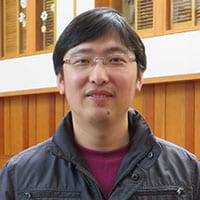Research Summary
My research interests mainly focus on the three-dimensional structures of biomolecules, i.e., proteins and enzymes. I employ computational biology and bioinformatics approaches to study the structure-function relationships of proteins and enzymes. Currently my projects are related to two subfields:
1) Pore-forming mechanism for cholesterol dependent cytolysins. These proteins are a large family of secreted bacterial toxins that specifically bind cholestero-containing mammalian membranes. The mechanism of pore formation of these proteins includes membrane binding of the monomer and their oligomerization into a circular prepore complex, followed by substantial structural changes as the prepore complex becomes a membrane-spanning beta-barrel pore.
2) Ion conductance and water transport mechanism for self-assembling subnanometer pores. We created organic nanotubes based on the stacking of shape-persistent macrocycles enforced by the cooperative interactions of pi-pi stacking and hydrogen bonding. In both the solid state and solution, the helical nanotubes with modifiable surfaces and a defined, noncollapsible inner pore are obtained. The resultant nanopore, in spite of being hydrophobic, exhibits unusual mass-transporting capabilities including highly selective ion conductance and efficient water transport across lipid bilayers.
Impact in China
Computational biology involves the development and application of data-analytical and theoretical methods, mathematical modeling, and computational simulations to study of biological, behavioral, and social systems. Researchers working on computational biology are very rate in China. It is my honor to be a Tang scholar at UC Berkeley, and to join Prof. Teresa Head-Gordon’s group. With the experiences of working with the world’s leading experts in computational biology, I hope to contribute to the development of the computational biology field in China.
Publications
Wang Y, Chen M, Wang H, Wang JF*, Bao D*. Microsatellites in the genome of the edible mushroom, volvariella volvacea. Biomedical Research International, 2014, 2014: 281912.
Ma LX, Wang YJ, Wang jF*, Li X, Hao P*. Expression sensitivity analysis of human disease related genes. Biomedical Research International, 2013, 2013: 637424.
Wang JF*, Chou KC. Metallo-β-lactamases: structural features, antibiotic recognition, inhibition, and inhibitor design. Current Topics on Medicinal Chemistry, 2013, 13(10): 1242-1253.
Cong S, Ma XT, Li YX, Wang JF*. Structural basis for the mutation-induced dysfunction of human CYP2J2: a computational study. Journal of Chemical Information and Modeling, 2013, 53(6): 1350-1357.
Liu Y, Liu BY, Hao P, Li X, Li YX, Wang JF*. Pi-pi stacking mediated drug-drug interactions in human CYP2E1. Proteins: Structure, Function, and Bioinformatics, 2013, 81(6): 945-954.
Xia XL, Cong S, Weng XR, Chen JH, Wang JF*, Chou KC. Molecular simulation to investigate the cofactor specificity for pichia stipitis xylose reductase. Medicinal Chemistry, 2013, 9(7): 985-992.
Wang YJ, Wang JF*, Ping J, Yu Y, Wang Y, Lian P, Li X, Li YX, Hao P*. Computational studies on the substrate interactions of influenza A virus PB2 subunit. PLoS ONE, 2012, 7(9): e44079.
Chen LL, Wang JL, Hu Y, Qian BJ, Yao XM, Wang JF*, Zhang JH*. Computational design of glutamate dehydrogenase in Bacillus subtillis natto. Journal of Molecular Modeling, 2013, 19(4): 1919-1927.
Zhang LS, Wang SQ, Xu WR, Wang RL, Wang JF*. Scaffold-based pan-agonist design for the PPARα, PPARβ and PPARγ receptors. PLos ONE, 2012, 7(10): e48453.
Wang Y, Wu XL, Wei DQ, Li YX, Wang JF*. Autoinhibitory mechanism for the mutation-induced impaired FGF9 signaling. Journal of Chemical Information and Modeling, 2012, 52(9): 2422-2429.
Wang JF*, Chou KC. Insights into the mutation-induced HHH syndrome from modeling human mitochondrial ornithine transporter-1. PLoS ONE, 2012, 7(1): e31048.
Wang JF, Hao P, Li YX, Dai JL, Li X. Exploration of conformational transition in the aryl-binding site of human FXa using molecular dynamics simulations. Journal of Molecular Modeling, 2012, 18(6): 2717-2725.
Ping J, Wang YJ, Wang JF*, Li X, Li YX, Hao P*. Negatively cooperative binding properties of human cytochrome P450 2E1 with monocyclic substrates. Current Drug Metabolism, 2012, 13(7): 1024-1031.
Li J, Wei DQ, Wang JF*, Li YX. A negative cooperatevity mechanism of human CYP2E1 inferred from molecular dynamics simulations and free energy calculations. Journal of Chemical Information and Modeling, 2011, 51(12): 3217-3225.
Lian P, Wei DQ, Wang JF*, Chou KC. An allosteric mechanism inferred from molecular dynamics simulations on phospholamban pentamer in lipid membranes. PLoS ONE, 2011, 6(4): e18587.
Wang JF*, Chou KC. Insights from modeling the 3D structure of New Delhi metallo-β-lactamse and its binding interactions with antibiotic drugs. PLoS ONE, 2011, 6(4): e188414.
(*Corresponding author)
